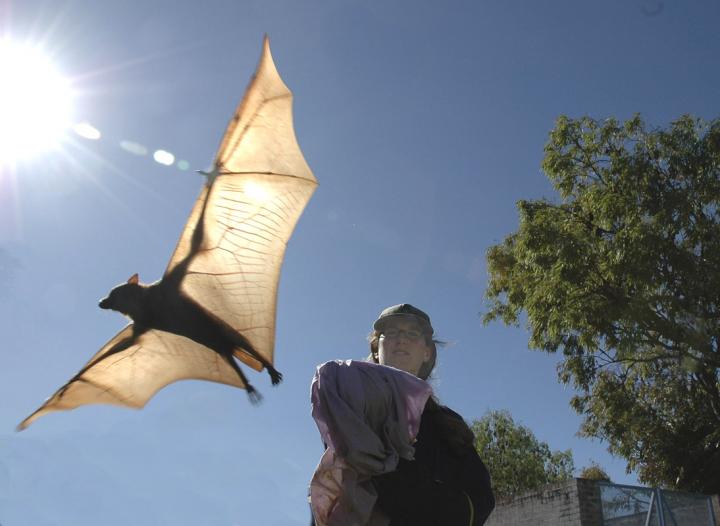
Credit: Shirley Plowright
BOZEMAN — In an effort to prevent some of the world’s most lethal diseases, an international research team spanning five continents and led by Montana State University will study bats in Australia, Bangladesh, Madagascar and Ghana.
Raina Plowright, assistant professor in the Department of Microbiology and Immunology in MSU’s College of Agriculture and College of Letters and Science, is leading a project to unravel the complex causes of bat-borne viruses that have recently made the jump to humans, causing concern among global health officials.
The research team — which includes more than 20 scientists from Johns Hopkins, Cornell, Cambridge, UCLA, Penn State, Rocky Mountain Laboratories in Montana, Griffith University in Australia and five other universities and institutions — is supported by a $10 million cooperative agreement with the Defense Advanced Research Projects Agency, or DARPA, an independent agency of the U.S. Defense Department that funds ambitious and potentially groundbreaking projects.
“This research brings together one of the biggest teams in the world working on emerging bat pathogens,” Plowright said, adding that the project will study how the viruses are transmitted at the cellular level as well as on the scale of whole landscapes. “Ultimately, what we’re trying to do is find new solutions that can prevent people from getting sick.”
Collectively called henipaviruses, the bat-borne pathogens were first identified in 1994 after an Australian outbreak of Hendra virus killed a dozen horses and their owner. Outbreaks of a related virus, called Nipah, have since resulted in hundreds of deaths in Malaysia, Bangladesh and India.
What most worries health experts, according to Plowright, is the potential for henipaviruses to cause future pandemics if human-to-human transmissions increase or new henipaviruses emerge that are more transmissible among humans. The diseases are highly lethal — up to three-quarters of infected individuals die — and there is no cure or vaccine for human infections.
According to Peter Hudson, Willaman Professor of Biology at Penn State University and the project’s co-principal investigator, insights into how and why henipaviruses jump to humans could also help prevent outbreaks of other bat-borne diseases such as SARS and Ebola, which killed about 11,000 people in West Africa from 2014 to 2016. Even as health workers struggle to treat Ebola victims and contain human-to-human transmission, scientists haven’t fully understood the human-bat interactions at the root cause of the problem, he said.
“I think we’re on the edge of finding out,” Hudson said.
Plowright’s prior research indicates that ecological changes such as deforestation may play a significant role in causing henipavirus outbreaks. For instance, her team found that incidents of Hendra virus in Australia are linked to bats flocking to urban and agricultural areas in response to loss of food sources in native forests, where the flying mammals play an important role in pollination. Those periods of nutritional stress are thought to suppress the bats’ immune systems and cause the animals to excrete viruses in urine and other body fluids. When horses eat contaminated grass beneath the trees where the bats feed, they become infected and pass the disease to humans. Similarly, Nipah virus in Bangladesh is transmitted to humans when bats feed on date-palm sap that is harvested and sold for human consumption.
“Henipaviruses are also found in bats across Africa and Asia, and we don’t know how many are spilling over into other animals and people in places with poor surveillance,” Plowright said.
Samples taken from the bats at the study locations will be sent to Rocky Mountain Labs, the National Institutes of Health facility in Hamilton, Montana, that is specially equipped to study emerging pathogens. Researchers there will inventory the viruses, document their genetic makeup and use controlled cell culture experiments to assess their ability to infect humans.
The team will analyze the bat samples for proteins that indicate the ability of the bat immune system to respond to viruses as well as environmental stress, potentially providing insights into how the diseases spread to humans. Meanwhile, field observations and satellite imagery will be used to track environmental variables such as changes in land-use. The changes will be studied for links to the bats’ having closer contact with humans and to the animals’ immune response as a result of nutritional stress, according to Plowright.
By putting together all of those pieces, Plowright said, the research team will develop mathematical models that predict outbreaks based on the presence of henipaviruses and environmental conditions that stress bat populations. That would give health officials information that could help them prepare for, or even prevent, future outbreaks, she said.
According to Plowright, one solution to these deadly diseases may be simpler than once thought: protecting bat habitat or even restoring native food sources such as flowering trees in areas away from people. “We think we might be able to solve this problem by solving the root cause,” she said.
###
Media Contact
Raina Plowright
[email protected]
406-994-2939
Original Source
http://www.
News source: https://scienmag.com/




